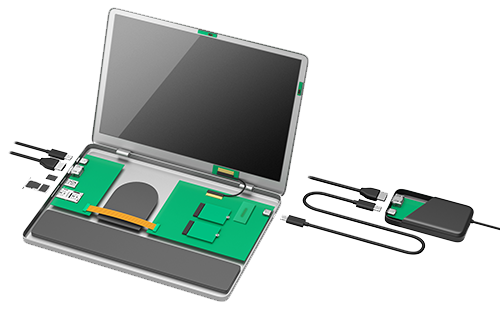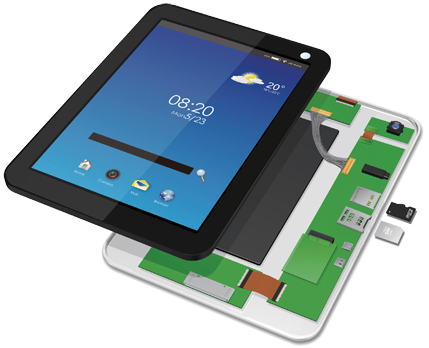About Connectors
Connectors are electronic components that link the flow of electric power and data signals.Connectors are used in modern society everywhere you look. We would like to introduce you to the functions and features of connectors, and the technology and production processes that support them.
Fields Where Connectors are Used
Connectors are widely used in devices we are all familiar with, from smartphones and computers, to various kinds of electronics-related equipment all over the world. Since connectors must conform precisely to the design specifications and requirements of the various devices, there is a broad spectrum of connectors. JAE alone has over 30,000 part numbers. Let’s look at the example of a computer to see what kind of connectivity functions connectors are used for.The first example is a memory socket connector that is used to connect memory chips mounted on printed circuit boards in computers.
Next, there are connectors for printed circuit boards themselves. These connect multiple printed circuit boards, commonly referred to as mother-boards and daughter-boards, for each electronic circuit function. In addition, there are also connectors for joining liquid crystal display panels and keyboards to printed circuit boards.
Lastly there are interface connectors.
These link the computer with printers, mobile devices, monitors, and other peripheral equipment. In addition, card connectors are also used to attach various types of cards.


The Benefits of Connectors
Why are connectors necessary?To connect various components and printed circuit boards inside equipment, it is possible to mount all the circuits directly on the board, but this task takes a lot of time. In addition, removing devices for repairs can also be time-consuming and expensive. However, by using a connector, connecting and disconnecting subassemblies can be done easily and quickly. High volume production, division of production, repairs and maintenance can all be accomplished more easily. This also applies to not only internal components, but also to the interface with peripheral equipment and networks.
In the development of various types of devices, the convenience of connectors for connecting and disconnecting is essential.

Structural Components of Connectors
A connector typically has 2 parts, a plug and a receptacle, that are paired to provide functionality. The plug and receptacle consist of electrical contacts, a plastic insulator that serves to house the contacts and provide insulation between the contacts, and an outer-layer called a shell that protects the other components.The contact is an essential component and is made of a high conductivity copper alloy. On one side is a pin contact without spring properties, on the opposite side is a socket contact with spring properties, that is designed to mate with the pin contact. When you insert a plug into a receptacle, the contacts form a solid connection with each other, and electric power and signals can flow.
